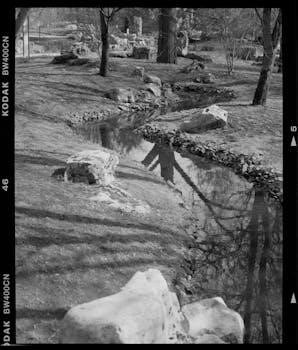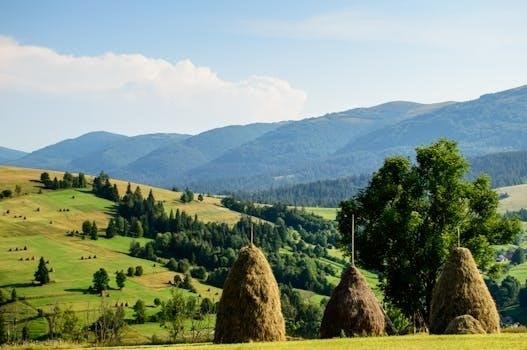The Genesis of the Wainwright Pictorial Guides
Alfred Wainwright’s deep passion for the Lake District fueled the creation of his renowned Pictorial Guides. His love affair with the region began at age 23, leading him to meticulously research and document the fells.
Alfred Wainwright’s Passion for the Lake District
Alfred Wainwright’s deep-seated love for the Lake District was the driving force behind his monumental work. This profound affection, ignited during a holiday at the age of 23, spurred a lifelong dedication to exploring and documenting the region’s fells. His passion wasn’t merely a casual interest; it was a consuming devotion that occupied every spare moment he had. He transformed his admiration into a meticulously crafted series of guidebooks, pouring his heart and soul into each page. This fervor for the Lakeland fells is evident in every hand-drawn map, every detailed route description, and every carefully chosen word, making his guides a true reflection of his profound connection with the area. His work wasn’t just a guide but a testament to his love for the region.
The Seven Volumes of the Pictorial Guides
Wainwright’s comprehensive work is presented in seven volumes, each dedicated to a specific area of the Lakeland Fells. These volumes offer detailed coverage for walkers and enthusiasts.
Publication Timeline⁚ 1955-1966
The publication of Alfred Wainwright’s iconic Pictorial Guides spanned over a decade, from 1955 to 1966. This period saw the release of all seven volumes by The Westmoreland Gazette, each meticulously crafted by Wainwright. The first volume, “The Eastern Fells,” marked the beginning of this extensive series, which detailed the fells of the Lake District. The subsequent volumes followed, each covering distinct geographical areas within the region. This 11-year undertaking resulted in the definitive guidebooks for generations of walkers, becoming a treasured resource for exploring the fells. The entire series was a monumental effort, reflecting Wainwright’s dedication.
Coverage of the Lakeland Fells
Wainwright’s Pictorial Guides provide comprehensive coverage of the Lakeland fells, dividing the region into seven distinct areas, each covered by one of the seven volumes. The guides meticulously detail 214 individual peaks, known locally as fells, encompassing the entire Lake District. From the Eastern Fells to the Western Fells, Wainwright’s work offers a complete geographic survey. Each fell is described with precision, aiding walkers in their exploration. The guides ensure that no corner of the Lake District is left undocumented, from the central fells to the far eastern ones, making them an invaluable resource for walkers and fell enthusiasts. The detailed coverage allows for a thorough exploration of the area.

Content and Style of the Guides
The Pictorial Guides are characterized by Wainwright’s unique style. They feature his hand-drawn maps and illustrations, alongside detailed route descriptions, making them both informative and visually appealing for walkers.
Hand-drawn Maps and Illustrations
A defining feature of Wainwright’s Pictorial Guides is his distinctive hand-drawn maps and illustrations. These were not simply functional; they were works of art, meticulously crafted with a personal touch. Every contour line, every fell, and every path was rendered with precision and care. The illustrations added a unique charm to the books, capturing the essence of the Lake District’s landscape. These were not just diagrams, they were a visual representation of his deep connection to the fells, enhancing the guides’ overall appeal and making them a joy to use. This artistic element set his work apart from other guidebooks.
Detailed Route Descriptions
Beyond the visual appeal, Wainwright’s guides provide meticulously detailed route descriptions. These were not merely lists of directions; they were carefully crafted narratives that guided the walker through the fells. Each route was described with precise instructions, often including distances, ascent information, and key landmarks. This attention to detail ensured that walkers, regardless of their experience level, could navigate the Lakeland fells with confidence. His descriptions were not just practical but infused with his personal observations and insights, making each walk feel like a shared journey. This combination of precision and personal touch became a hallmark of his guides.

Legacy and Impact
Wainwright’s guides became definitive resources for generations of walkers. His work established the 214 Wainwright fells as a sought-after challenge, shaping the culture of fellwalking in the Lake District.
Definitive Guidebooks for Generations
Alfred Wainwright’s seven-volume Pictorial Guides, published between 1955 and 1966, have become the quintessential guidebooks for exploring the Lake District fells. These meticulously crafted books, born from Wainwright’s profound love for the region, have been cherished by countless walkers across generations. They are not just maps; they are a testament to his dedication and passion, offering a unique blend of detailed information and personal artistry. The guides have stood the test of time, remaining essential companions for those who seek to experience the beauty and challenge of the Lakeland fells. Their enduring popularity solidifies their place as a cornerstone of fellwalking culture.
The 214 Wainwright Fells
The Wainwright Pictorial Guides are best known for defining the 214 fells of the Lake District, commonly referred to as “Wainwrights.” These fells, meticulously detailed within the seven volumes, have become a significant goal for many fellwalkers. The act of “bagging the Wainwrights” has become a popular pursuit, with walkers aiming to summit all 214 peaks. These fells, varying in height and difficulty, provide a comprehensive challenge for those who explore the Lake District. The guides detail the routes to each of these fells, establishing them as the definitive reference for achieving this iconic Lakeland challenge. The list of 214 fells has become synonymous with fellwalking in the Lake District.
Revised Editions and Updates
The original Pictorial Guides have seen revisions, notably by Clive Hutchby, who created the “Walkers Editions.” These updates ensure the guides remain practical for contemporary walkers, with adjusted routes and information.
Clive Hutchby’s Walkers Editions
Clive Hutchby undertook the significant task of revising Wainwright’s original guides, creating what are known as the “Walkers Editions.” These editions aimed to update the information, ensuring the guides remained relevant and practical for modern fell walkers. Hutchby’s work involved carefully reviewing the original routes and descriptions, making necessary adjustments to reflect changes in paths and access. The Walkers Editions retained the spirit and charm of Wainwright’s original work, while providing updated maps and clearer route guidance. Hutchby’s revisions have been crucial in ensuring that Wainwright’s guides continue to be the definitive source for exploring the Lakeland fells, remaining invaluable for new generations of walkers.
Chris Jesty’s Role in Future Revisions
Chris Jesty was specifically chosen by Alfred Wainwright himself to handle any future revisions of the Pictorial Guides. This speaks volumes about Jesty’s expertise and dedication to maintaining the integrity of Wainwright’s work. Jesty’s role involved ensuring the guides remained accurate and up-to-date, addressing any changes in the landscape or access routes. His revisions were intended to honor the original spirit of Wainwright’s guides while making them even more useful for contemporary walkers. Jesty’s meticulous approach and deep understanding of the fells have solidified his position as the guardian of Wainwright’s legacy, guaranteeing the guides’ continued relevance and value for generations to come. His work is vital to preserving the original vision.

Collectibility and Rarity
First editions of the Pictorial Guides, especially those with original dust wrappers, are highly sought after by collectors. Boxed sets and anniversary editions also command premium prices due to their scarcity.
First Editions and Dust Wrappers
The initial printings of Alfred Wainwright’s Pictorial Guides, known as first editions, hold significant value among collectors. These early copies, published between 1955 and 1966, are particularly desirable when they retain their original dust wrappers. The condition of the dust wrapper is crucial, as even minor flaws can impact the book’s worth. Finding a complete set of first editions with dust wrappers intact is exceptionally rare, making them highly prized by enthusiasts. The first volume, “The Eastern Fells,” is often found without its dust jacket, adding to the challenge of assembling a complete set in pristine condition. Internal repairs, though sometimes necessary, can also affect value.
Boxed Sets and Anniversary Editions
Beyond individual first editions, boxed sets of the Wainwright Pictorial Guides are highly sought after by collectors. These sets, often custom-made slipcases, provide a convenient and attractive way to store the seven volumes. In addition, special anniversary editions have been released to commemorate the original publication dates, further increasing collectability. These anniversary editions often feature updated content, enhanced illustrations, or additional materials. They are designed to appeal to both long-time fans and new generations of walkers. This boxed set contains all seven of the Pictorial Guides to the Lakeland Fells by the fell walking legend, A. Wainwright. This offers a comprehensive collection for those keen on exploring the Lake District.

Beyond the Pictorial Guides
Alfred Wainwright’s literary contributions extend past the famed Pictorial Guides. He also authored works like “A Coast to Coast Walk,” and “The Outlying Fells of Lakeland,” showcasing his passion.
Other Wainwright Works
While the Pictorial Guides remain his magnum opus, Alfred Wainwright’s literary legacy includes several other notable works. Beyond the fells, he documented long-distance paths, such as the popular “Coast to Coast Walk,” offering a different perspective on the British landscape. He also explored the less-traveled areas with “The Outlying Fells of Lakeland,” and “Walks in Limestone Country,” catering to those seeking alternative walking experiences. “Pennine Way Companion” and “Walks on the Howgill Fells” further demonstrate his dedication to sharing the beauty of the UK’s countryside. These works collectively highlight his comprehensive knowledge and passion for walking and the outdoors.
Coast to Coast Walk
Alfred Wainwright’s “Coast to Coast Walk” stands as a testament to his love for long-distance hiking, distinct from his Lakeland guides. This work details a challenging route spanning northern England, from the Irish Sea to the North Sea. Unlike the fell-centric Pictorial Guides, this book guides walkers across a diverse landscape, including moorlands, valleys, and fells. Wainwright’s meticulous approach remains evident in the hand-drawn maps and detailed route descriptions. This guide has become a classic, inspiring hikers to experience the beauty and ruggedness of the English countryside. It showcases his broader passion for the outdoors beyond Lakeland.
Where to Find the Guides
Wainwright’s guides can be found at online retailers and marketplaces, often including rare first editions. Specialist bookshops also carry these treasured guides, catering to collectors and enthusiasts alike.
Online Retailers and Marketplaces
The digital age has made accessing Wainwright’s Pictorial Guides easier than ever. Online platforms like Amazon and eBay offer a wide selection, from individual volumes to complete boxed sets. Both new and used editions can be found, catering to different budgets and collecting interests. These marketplaces also frequently list first editions and anniversary editions, attracting avid collectors. Be sure to check the seller’s ratings and description carefully, especially when buying older or rarer volumes. Online retailers provide the advantage of browsing from home and comparing prices before making a purchase. You can find everything from the standard guides to more specialist items.
Specialist Bookshops
For those seeking a more curated experience, specialist bookshops, particularly those focusing on mountaineering, travel, or local interest, often stock Wainwright’s Pictorial Guides. These shops can provide a more personal service, with knowledgeable staff able to offer guidance and advice. They may also carry rarer editions or unique items not found on larger online marketplaces. Browsing in person allows you to examine the condition of the books closely, particularly important for older volumes. Specialist bookshops often have a selection of related items, such as maps and walking guides, enriching the experience for enthusiasts. They provide a tangible connection to the history and legacy of Wainwright’s work.
